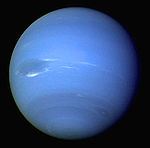- Naiad (moon)
-
Naiad  Naiad or Thalassa as seen by Voyager 2 (smearing has caused excessive elongation)Discovery
Naiad or Thalassa as seen by Voyager 2 (smearing has caused excessive elongation)DiscoveryDiscovered by Voyager Imaging Team Discovery date September 1989 Epoch 18 August 1989 Semi-major axis 48 227 ± 1 km Eccentricity 0.0004 ± 0.0003 Orbital period 0.2943958 ± 0.0000002 d Inclination - 4.75 ± 0.03° (to Neptune equator)
- 4.75° (to local Laplace plane)
Satellite of Neptune Physical characteristicsDimensions 96×60×52 km[2][3] Mean radius 33 ± 3 km[4] Volume ~1.5×105km³ Mass ~1.9×1017 kg
(based on assumed density)Mean density ~1.3 g/cm³ (estimate)[4] Equatorial surface gravity ~0.012 m/s2[a] Escape velocity ~0.028 km/s[b] Rotation period synchronous Axial tilt zero Albedo 0.07[2][4] Temperature ~51 K mean (estimate) Apparent magnitude 23.9[4] Naiad (
 /ˈneɪ.əd/ nay-əd or /ˈnaɪ.əd/ ny-əd; Greek: Ναϊάδ-ες), also known as Neptune III, is the innermost satellite of Neptune, named after the Naiads of Greek legend.[5]
/ˈneɪ.əd/ nay-əd or /ˈnaɪ.əd/ ny-əd; Greek: Ναϊάδ-ες), also known as Neptune III, is the innermost satellite of Neptune, named after the Naiads of Greek legend.[5]Naiad was discovered sometime before mid-September 1989 from the images taken by the Voyager 2 probe. The last moon to be discovered during the flyby, it was designated S/1989 N 6.[6] The discovery was announced on September 29, 1989, in the IAU Circular No. 4867, but the text only talks of "25 frames taken over 11 days", giving a discovery date of sometime before September 18. The name was given on 16 September 1991.[7]
Naiad is irregularly shaped and probably has not been modified by any internal geological processes after its formation. It is likely that it is a rubble pile re-accreted from fragments of Neptune's original satellites, which were smashed up by perturbations from Triton soon after that moon's capture into a very eccentric initial orbit.[8]
Naiad orbits about 23,500 km above Neptune's cloud tops. Since this is below the synchronous orbit radius, its orbit is slowly decaying due to tidal deceleration and may eventually impact Neptune's atmosphere, or break up into a planetary ring upon passing its Roche limit due to tidal stretching. Naiad orbits Neptune well within its fluid Roche limit, and its density is expected to be low enough that it may be very close to its actual Roche limit already.[citation needed]
Since the Voyager 2 flyby, the Neptune system has been extensively studied from ground-based observatories and the Hubble Space Telescope as well. In 2002–03 the Keck telescope observed the system using adaptive optics and detected easily the largest four inner satellites. Thalassa was found with some image processing, but Naiad was not located.[9] Hubble has the ability to detect all the known satellites and possible new satellites even dimmer than Voyager 2. Still, Naiad has not been found. It is suspected that this is due to considerable errors in Naiad's ephemeris.[10]
Notes
- ^ Surface gravity derived from the mass m, the gravitational constant G and the radius r: Gm/r2.
- ^ Escape velocity derived from the mass m, the gravitational constant G and the radius r: √2Gm/r.
References
- ^ Jacobson, R. A.; Owen, W. M., Jr. (2004). "The orbits of the inner Neptunian satellites from Voyager, Earthbased, and Hubble Space Telescope observations". Astronomical Journal 128 (3): 1412–1417. Bibcode 2004AJ....128.1412J. doi:10.1086/423037.
- ^ a b Karkoschka, Erich (2003). "Sizes, shapes, and albedos of the inner satellites of Neptune". Icarus 162 (2): 400–407. Bibcode 2003Icar..162..400K. doi:10.1016/S0019-1035(03)00002-2.
- ^ Williams, Dr. David R. (2008-01-22). "Neptunian Satellite Fact Sheet". NASA (National Space Science Data Center). http://nssdc.gsfc.nasa.gov/planetary/factsheet/neptuniansatfact.html. Retrieved 2008-12-13.
- ^ a b c d "Planetary Satellite Physical Parameters". JPL (Solar System Dynamics). 2008-10-24. http://ssd.jpl.nasa.gov/?sat_phys_par. Retrieved 2008-12-13.
- ^ "Planet and Satellite Names and Discoverers". Gazetteer of Planetary Nomenclature. USGS Astrogeology. July 21, 2006. http://planetarynames.wr.usgs.gov/append7.html. Retrieved 2006-08-05.
- ^ Green, Daniel W. E. (September 29, 1989). "Neptune". IAU Circular 4867. http://www.cbat.eps.harvard.edu/iauc/04800/04867.html. Retrieved 2011-10-26.
- ^ Marsden, Brian G. (September 16, 1991). "Satellites of Saturn and Neptune". IAU Circular 5347. http://www.cbat.eps.harvard.edu/iauc/05300/05347.html. Retrieved 2011-10-26.
- ^ Banfield, Don; Murray, Norm (October 1992). "A dynamical history of the inner Neptunian satellites". Icarus 99 (2): 390–401. Bibcode 1992Icar...99..390B. doi:10.1016/0019-1035(92)90155-Z.
- ^ Marchis, F.; Urata, R.; de Pater, I.; Hammel, H. B.; Berthier, J. (May, 2004). "Neptunian Satellites observed with Keck AO system". American Astronomical Society, DDA meeting #35, #07.08; Bulletin of the American Astronomical Society, Vol. 36. pp. 860. http://adsabs.harvard.edu/cgi-bin/nph-bib_query?bibcode=2004DDA....35.0708M&db_key=AST&data_type=HTML&format=&high=4489edb0bc24666. Retrieved 2006-08-05.
- ^ Showalter, M. R.; Lissauer, J. J.; de Pater, I. (August, 2005). "The Rings of Neptune and Uranus in the Hubble Space Telescope". American Astronomical Society, DPS meeting #37, #66.09; Bulletin of the American Astronomical Society, Vol. 37. pp. 772. http://adsabs.harvard.edu/cgi-bin/nph-bib_query?bibcode=2005DPS....37.6609S&db_key=AST&data_type=HTML&format=&high=4489edb0bc15539. Retrieved 2006-08-05.
External links
Moons of Neptune Generally listed in increasing distance from NeptuneRegular (inner) Triton Irregular See also Neptune Discovery 
Characteristics - Rings
- Great Dark Spot
- Small Dark Spot
- The Scooter
- Kuiper belt
Moons Exploration Trojans Miscellaneous Categories:
Wikimedia Foundation. 2010.

